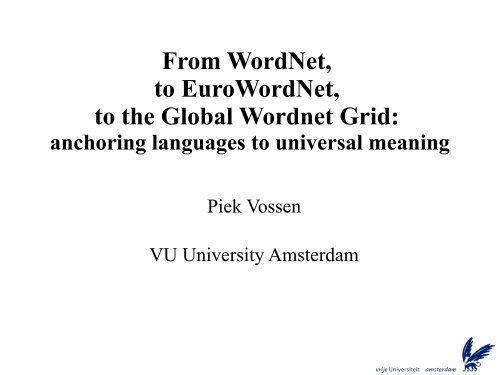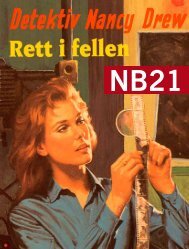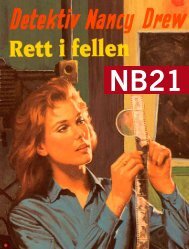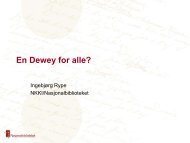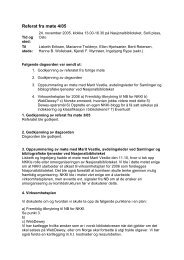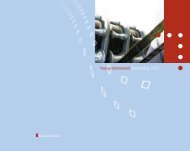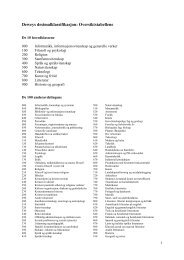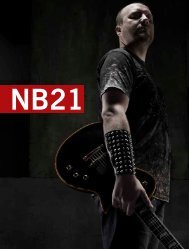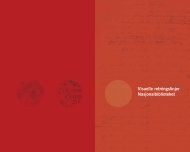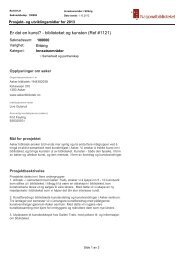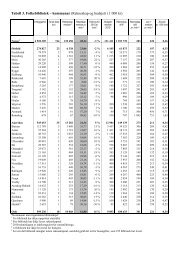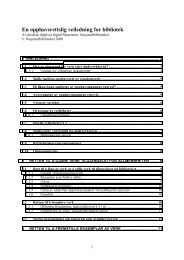You also want an ePaper? Increase the reach of your titles
YUMPU automatically turns print PDFs into web optimized ePapers that Google loves.
From WordNet,<br />
to EuroWordNet,<br />
to the Global <strong>Wordnet</strong> Grid:<br />
anchoring languages to universal meaning<br />
Piek Vossen<br />
VU University Amsterdam<br />
1
Princeton WordNet<br />
• http://wordnet.princeton.edu/<br />
• Developed by George Miller and his team at<br />
Princeton University, as the implementation of<br />
a mental model of the lexicon<br />
• Organized around the notion of a synset: a set<br />
of synonyms in a language that represent a<br />
single concept<br />
• Semantic relations between concepts<br />
• Covers over 117,000 concepts and over<br />
150,000 English words<br />
2
What kind of resource is<br />
WordNet?<br />
• Mostly used database in language<br />
technology<br />
• Enormous impact in language technology<br />
development<br />
• Large<br />
• Free and downloadable<br />
• English<br />
3
<strong>Wordnet</strong> Starting point<br />
• Lexical database organized around concepts instead of lexical<br />
forms:<br />
– Separates lexical forms from concepts<br />
– Defines concepts through a relational model of meaning and<br />
not an encyclopedic view<br />
• Concept is defined by the notion of a synset, synsets distinguish<br />
word meanings:<br />
– {board, plank}{board, plank} {board, committee}{board, get on}<br />
• The ‘synset’ as a weak notion of synonymy:<br />
“two expressions are synonymous in a linguistic context C if the<br />
substitution of one for the other in C does not alter the truth<br />
value.” (Miller et al. 1993)<br />
4
<strong>Wordnet</strong>: a network of semantically<br />
related words<br />
{conveyance;transport}<br />
{vehicle}<br />
{motor vehicle; automotive vehicle}<br />
{car; auto; automobile; machine; motorcar}<br />
{cruiser; squad car; patrol car;<br />
police car; prowl car}<br />
{car door}<br />
{bumper}<br />
{cab; taxi; hack; taxicab}<br />
{car mirror}<br />
{car window}<br />
{armrest}<br />
{doorlock}<br />
{hinge;<br />
flexible joint}<br />
5
Polysemy & Word Forms<br />
Synsets (word meanings)<br />
contain one or more<br />
word forms<br />
Word forms in multiple<br />
synsets are polysemous<br />
Polysemous word forms<br />
are said to have multiple<br />
senses
Polysemy, Familiarity<br />
& Zipf's Law<br />
Zipf's law:<br />
There is a constant k such that f * r = k<br />
In words: there is a predictable relation between the<br />
frequency of a word and its rank<br />
Zipf's other law:<br />
The number of meanings of a word is related to its<br />
frequency of use<br />
Polysemy indicates familiarity in wordnet:<br />
• “horse” horse” has 6 meanings, “equus caballus” has 1
Familiarity & SemCor<br />
Sense numbers indicate frequency in SemCor (250,000<br />
tokens from Brown corpus manually tagged with WordNet<br />
senses):<br />
• {horse:1, Equus caballus:1} => animal<br />
• {horse:5, knight:2} => in chess
<strong>Wordnet</strong> 3.0 statistics<br />
POS Unique Synsets Total<br />
Strings Word-Sense<br />
Pairs<br />
Noun 117,798 82,115 146,312<br />
Verb 11,529 13,767 25,047<br />
Adjective 21,479 18,156 30,002<br />
Adverb 4,481 3,621 5,580<br />
Totals 155,287 117,659 206,941<br />
9
<strong>Wordnet</strong> 3.0 statistics<br />
POS Monosemous Polysemous Polysemous<br />
Words and<br />
Senses<br />
Words Senses<br />
Noun 101,863 15,935 44,449<br />
Verb 6,277 5,252 18,770<br />
Adjective 16,503 4,976 14,399<br />
Adverb 3,748 733 1,832<br />
Totals 128,391 26,896 79,450<br />
10
Semantic organization of<br />
Nouns in WordNet<br />
25 unique beginners
noun.Tops file<br />
Contains very general classifi cations
Lexicalization patterns<br />
building<br />
church<br />
abbey<br />
artifact<br />
bird<br />
object<br />
canary<br />
common<br />
canary<br />
animal<br />
dog<br />
entity<br />
organism<br />
crocodile<br />
tree<br />
plant<br />
fl ower<br />
rose<br />
top-layer<br />
25 unique<br />
beginners<br />
Basic Level<br />
Concepts<br />
(Rosch)<br />
13
Lexicalization patterns<br />
building<br />
church<br />
abbey<br />
artifact<br />
bird<br />
object<br />
canary<br />
common<br />
canary<br />
animal<br />
dog<br />
entity<br />
organism<br />
crocodile<br />
tree<br />
plant<br />
fl ower<br />
• balance of two rose principles:<br />
top-layer<br />
25 unique<br />
beginners<br />
basic level<br />
concepts<br />
● predict most features<br />
● apply to most subclasses<br />
• where most concepts are created<br />
• amalgamate most parts<br />
• most abstract level to draw a pictures<br />
14
inessential<br />
souvenir<br />
garbage<br />
threat<br />
Lexicalization patterns<br />
building<br />
church<br />
abbey<br />
artifact<br />
bird<br />
object<br />
canary<br />
common<br />
canary<br />
entity<br />
animal<br />
dog<br />
organism<br />
crocodile<br />
tree<br />
plant<br />
top-layer<br />
curiosity<br />
....etc....<br />
waste<br />
25 unique<br />
variable beginners<br />
fl ower<br />
rose<br />
basic level<br />
concepts<br />
15
inessential<br />
souvenir<br />
garbage<br />
threat<br />
Lexicalization patterns<br />
building<br />
church<br />
abbey<br />
artifact<br />
bird<br />
object<br />
canary<br />
common<br />
canary<br />
entity<br />
animal<br />
dog<br />
organism<br />
crocodile<br />
tree<br />
plant<br />
top-layer<br />
curiosity<br />
....etc....<br />
waste<br />
25 unique<br />
variable beginners<br />
fl ower<br />
rose<br />
basic level<br />
concepts<br />
16
<strong>Wordnet</strong> top level<br />
17
leg<br />
Meronymy & pictures<br />
beak<br />
tail<br />
18
Meronymy & pictures<br />
19
Dogs in WordNet<br />
20
Type-role distinction<br />
• Current WordNet treatment:<br />
(1) a husky is a kind of dog (type)<br />
(2) a husky is a kind of working dog (role)<br />
• What’s wrong?<br />
(2) is defeasible, (1) is not:<br />
*This husky is not a dog<br />
This husky is not a working dog<br />
Other roles: watchdog, sheepdog, herding dog, lapdog, etc….<br />
21
Ontological observations<br />
• Identity criteria as used in OntoClean (Guarino &<br />
Welty 2002):<br />
– rigidity: to what extent are properties true for all<br />
instances of entities in all worlds? You are always a<br />
human, but you can be a student for a short while.<br />
• Ignoring this distinction leads to ISA-overloading<br />
22
Ontology and lexicon<br />
• Hierarchy of disjunct types:<br />
Canine => PoodleDog; NewfoundlandDog;<br />
GermanShepherdDog; Husky<br />
• Lexicon:<br />
– NAMES for TYPES:<br />
{poodle}EN, {poedel}NL, {pudoru}JP<br />
=> ((instance x Poodle)<br />
– LABELS for ROLES:<br />
{watchdog}EN, {waakhond}NL, {banken}JP<br />
=>((instance x Canine) and (role x GuardingProcess))<br />
23
Expansion with pure hyponymy<br />
lapdog<br />
relations<br />
dog<br />
hunting dog puppy<br />
street dog<br />
watchdog<br />
poodle<br />
short hair<br />
dachshund<br />
dachshund<br />
long hair<br />
dachshund<br />
bitch<br />
Expansion from a type to roles<br />
24
Expansion with pure hyponymy<br />
lapdog<br />
relations<br />
dog<br />
hunting dog puppy<br />
street dog<br />
watchdog<br />
poodle<br />
short hair<br />
dachshund<br />
dachshund<br />
long hair<br />
dachshund<br />
bitch<br />
Expansion from a role to types and other roles<br />
25
Synset definition<br />
Synsets consist of interchangeable words or synonyms (Miller, 1998)<br />
loose criteria<br />
lion, king_of_beasts,<br />
Panthera_leo [large gregarious<br />
predatory feline of Africa and India<br />
having a tawny coat with a shaggy<br />
mane in the male]<br />
strict criteria<br />
dog, domestic doc, canis<br />
familiaris (a member of the<br />
genus Canis..)<br />
Pooch, doggie, doggy,<br />
barker, bow-wow (informal<br />
terms for dogs)<br />
26
Differences among wordnets<br />
English <strong>Wordnet</strong><br />
large number of synsets<br />
asshole, bastard, cocksucker, dickhead, shit,<br />
mother fucker, motherfucker, prick, whoreson,<br />
son of a bitch, SOB<br />
cad, bounder, blackguard, dog, hound, heel<br />
gasbag, windbag<br />
rotter, rat, skunk, stinker, bum, puke, crumb,<br />
lowlife, scum_bag, so-and-so<br />
pain, pain_in_the_neck, nuisance<br />
worm, louse, insect, dirt_ball<br />
Dutch <strong>Wordnet</strong><br />
62 synonyms<br />
naarling:1/r_n-24518, beroerling:1/d_n-26921,<br />
ellendeling:1/r_n-12324, etterbak:1/d_n-75936,<br />
etterbuil:2/d_n-75940, fielt:1/d_n-80137,<br />
fluim:2/d_n-81948, gemenerik:1/r_n-14607,<br />
hond:2/r_n-79023, hondenlul:1/r_n-17019,<br />
kankerlijer:1/d_n-130709, kelerelijder:1/d_n-<br />
540923, kelerelijer:1/d_n-147148,<br />
klerelijer:1/r_n-19790, kloot:1/r_n-19887,<br />
kloothommel:1/d_n-137246, klootspiraal:1/d_n-<br />
412711, klootzak:1/r_n-19888, kwal:2/r_n-<br />
21077, lamgat:1/d_n-152244, lammeling:1/r_n-<br />
21272, lamstraal:1/d_n-152396, lamzak:1/r_n-<br />
21286, lazersteen:1/d_n-413025,<br />
lazerstraal:1/d_n-154087, loeder:1/r_n-22410,<br />
lul:2/r_n-22757, lulhannes:1/d_n-161976,<br />
lulletje:1/d_n-541138, miesgasser:1/d_n-<br />
172163, mispunt:1/r_n-24006, onverlaat:1/r_n-<br />
26320, paardelul:1/d_n-228940,<br />
paardenlul:1/n_n-501022, patjakker:1/d_n-<br />
212558, pleurislijder:1/r_n-28842, ploert:1/r_n-<br />
28881, plurk:1/d_n-220067, etc. etc.<br />
insulting terms for people who are stupid, ridiculous, irritating, lazy, slow, ……<br />
27
Splitting or Lumping<br />
Lumping<br />
“one denotation and several connotations per synset”<br />
lion, king_of_beasts, Panthera_leo<br />
Splitting<br />
“one denotation and one connotation per synset”<br />
Kraut, Krauthead, Jerry, Hun<br />
German<br />
hyponym
Splitting<br />
• On which criteria? Usage (register, domain,<br />
frequency, style, etc.); Attitude (polarity,<br />
subjectivity); Morphology, Syntax, etc.<br />
• Consequent splitting leads to synsets without<br />
synonyms<br />
• Leads to ISA-overloading (german is not a<br />
hypernym of krauthead)
Lumping<br />
• Consequent lumping leads to extremely<br />
large synsets<br />
• Low interchangeability of synonyms as<br />
their connotations differ too much<br />
• Low interoperability between wordnets:<br />
precise translation equivalence is impossible<br />
• Leads to ‘unintuitive’ synsets
Hybrid and 2-layered
Summary<br />
• Synsets are more compact representations for concepts than word<br />
meanings in traditional lexicons<br />
• Synonyms and hypernyms are substitutional variants:<br />
– begin – commence<br />
– I once had a canary. The bird got sick. The poor animal died.<br />
• Hyponymy and meronymy chains are important transitive relations for<br />
predicting properties and explaining textual properties:<br />
object -> artifact -> vehicle -> 4-wheeled vehicle -> car<br />
• Strict separation of part of speech although concepts are closely<br />
related (bed – sleep) and are similar (dead – death)<br />
• Lexicalization patterns reveal important mental structures<br />
32
EuroWordNet<br />
• The development of a multilingual database with wordnets<br />
for several European languages<br />
• Funded by the European Commission, DG XIII,<br />
Luxembourg as projects LE2-4003 and LE4-8328<br />
• March 1996 - September 1999<br />
• 2.5 Million EURO.<br />
• http://www.hum.uva.nl/~ewn<br />
• http://www.illc.uva.nl/EuroWordNet/fi nalresults-ewn.html<br />
33
EuroWordNet<br />
• Languages covered:<br />
– EuroWordNet-1 (LE2-4003): English, Dutch, Spanish, Italian<br />
– EuroWordNet-2 (LE4-8328): German, French, Czech, Estonian.<br />
• Size of vocabulary:<br />
– EuroWordNet-1: 30,000 concepts - 50,000 word meanings.<br />
– EuroWordNet-2: 15,000 concepts- 25,000 word meaning.<br />
• Type of vocabulary:<br />
– the most frequent words of the languages<br />
– all concepts needed to relate more specifi c concepts<br />
34
EuroWordNet Model<br />
ride<br />
move<br />
go<br />
III<br />
III<br />
drive<br />
Lexical Items Table<br />
Lexical Items Table<br />
cabalgar<br />
jinetear<br />
III<br />
III<br />
mover<br />
transitar<br />
conducir<br />
Domains<br />
Traffic<br />
ILI-record<br />
{drive}<br />
Ontology<br />
2OrderEntity<br />
Air Road` Location Dynamic<br />
III<br />
rijden berijden<br />
I<br />
I<br />
III<br />
II<br />
II<br />
Lexical Items Table<br />
II<br />
Inter-Lingual-Index<br />
I = Language Independent link<br />
II = Link from Language Specific<br />
to Inter lingual Index<br />
III = Language Dependent Link<br />
II<br />
guidare<br />
bewegen<br />
gaan<br />
Lexical Items Table<br />
III<br />
III<br />
andare<br />
muoversi<br />
cavalcare<br />
35
Differences in relations between<br />
EuroWordNet and WordNet<br />
• Added Features to relations<br />
• Cross-Part-Of-Speech relations<br />
• New relations to differentiate shallow hierarchies<br />
• Different interpretations of some relations<br />
36
Cross-Part-Of-Speech relations<br />
WordNet1.5: nouns and verbs are not interrelated by basic semantic<br />
relations such as hyponymy and synonymy:<br />
adornment 2 => change of state-- (the act of changing something)<br />
adorn 1 => change, alter-- (cause to change; make different)<br />
EuroWordNet: words of different parts of speech can be inter-linked with<br />
explicit xpos-synonymy, xpos-antonymy and xpos-hyponymy relations:<br />
{adorn V} XPOS_NEAR_SYNONYM {adornment N}<br />
{size N} XPOS_NEAR_HYPONYM {tall A}<br />
{short A}<br />
37
Role relations<br />
In the case of many verbs and nouns the most salient relation is not the hyperonym<br />
but the relation between the event and the involved participants. These relations<br />
are expressed as follows:<br />
{knife} ROLE_INSTRUMENT {to cut}<br />
{to cut} INVOLVED_INSTRUMENT {knife} reversed<br />
{school} ROLE_LOCATION {to teach}<br />
{to teach} INVOLVED_LOCATION {school} reversed<br />
These relations are typically used when other relations, mainly hyponymy, do not<br />
clarify the position of the concept network, but the word is still closely related to<br />
another word.<br />
38
Co_Role relations<br />
guitar player HAS_HYPERONYM player<br />
CO_AGENT_INSTRUMENT guitar<br />
player HAS_HYPERONYM person<br />
ROLE_AGENT to play music<br />
CO_AGENT_INSTRUMENT musical instrument<br />
to play music HAS_HYPERONYM to make<br />
ROLE_INSTRUMENT musical instrument<br />
guitar HAS_HYPERONYM musical instrument<br />
CO_INSTRUMENT_AGENT guitar player<br />
ice saw HAS_HYPERONYM saw<br />
CO_INSTRUMENT_PATIENT ice<br />
saw HAS_HYPERONYM saw<br />
ROLE_INSTRUMENT to saw<br />
ice CO_PATIENT_INSTRUMENT ice saw REVERSED<br />
39
Horizontal & vertical semantic relations<br />
chronical patient ;<br />
mental patient<br />
HYPONYM<br />
STATE<br />
patient<br />
disease; disorder<br />
HYPONYM<br />
stomach disease,<br />
kidney disorder,<br />
ρ-PATIENT<br />
ρ-PATIENT<br />
physiotherapy<br />
medicine<br />
etc.<br />
ρ-CAUSE<br />
ρ-INSTRUMENT<br />
cure<br />
treat<br />
hospital, etc.<br />
ρ-LOCATION<br />
ρ-AGENT<br />
docter<br />
HYPONYM<br />
child docter<br />
co-ρ-<br />
AGENT-PATIENT<br />
child<br />
40
Overview of the Language<br />
Internal relations in Euro<strong>Wordnet</strong><br />
Same Part of Speech relations:<br />
NEAR_SYNONYMY apparatus - machine<br />
HYPERONYMY/HYPONYMY car - vehicle<br />
ANTONYMY open - close<br />
HOLONYMY/MERONYMY head - nose<br />
Cross-Part-of-Speech relations:<br />
XPOS_NEAR_SYNONYMY dead - death; to adorn - adornment<br />
XPOS_HYPERONYMY/HYPONYMY to love - emotion<br />
XPOS_ANTONYMY to live - dead<br />
CAUSE die - death<br />
SUBEVENT buy - pay; sleep - snore<br />
ROLE/INVOLVED write - pencil; hammer - hammer<br />
STATE the poor - poor<br />
MANNER<br />
BELONG_TO_CLASS<br />
to slurp - noisily<br />
Rome - city<br />
41
The Multilingual Design<br />
• Inter-Lingual-Index: unstructured fund of concepts to<br />
provide an effi cient mapping across the languages;<br />
• Index-records are mainly based on WordNet synsets and<br />
consist of synonyms, glosses and source references;<br />
• Various types of complex equivalence relations are<br />
distinguished;<br />
• Equivalence relations from synsets to index records: not on a<br />
word-to-word basis;<br />
• Indirect matching of synsets linked to the same index items;<br />
42
Equivalent Near Synonym<br />
1. Multiple Targets (1:many)<br />
Dutch wordnet: schoonmaken (to clean) matches with 4<br />
senses of clean in WordNet1.5:<br />
● make clean by removing dirt, filth, or unwanted substances from<br />
● remove unwanted substances from, such as feathers or pits, as of chickens or fruit<br />
● remove in making clean; "Clean the spots off the rug"<br />
● remove unwanted substances from - (as in chemistry)<br />
2. Multiple Sources (many:1)<br />
Dutch wordnet: versiersel near_synonym versiering<br />
ILI-Record: decoration.<br />
3. Multiple Targets and Sources (many:many)<br />
Dutch wordnet: toestel near_synonym apparaat<br />
ILI-records: machine; device; apparatus; tool<br />
43
EN-Net<br />
toe<br />
finger<br />
head<br />
NL-Net<br />
hoofd<br />
kop<br />
Complex mappings across<br />
languages<br />
{ toe : part of foot }<br />
{ finger : part of hand }<br />
{ dedo , dito :<br />
finger or toe }<br />
{ head : part of body }<br />
{ hoofd : human head }<br />
{ kop : animal head }<br />
= normal equivalence<br />
= eq _has_hyponym<br />
= eq _has_hyperonym<br />
IT-Net<br />
dito<br />
ES-Net<br />
dedo<br />
44
Typical gaps in the (English)<br />
ILI<br />
• Dutch:<br />
doodschoppen (to kick to death):<br />
eq_hyperonym {kill}V and to {kick}V<br />
aardig (Adjective, to like):<br />
eq_near_synonym {like}V<br />
cassière (female cashier)<br />
eq_hyperonym {cashier}, {woman}<br />
kunstproduct (artifact substance)<br />
eq_hyperonym {artifact} and to {product}<br />
• Spanish:<br />
alevín (young fi sh):<br />
eq_hyperonym {fi sh} and eq_be_in_state {young}<br />
cajera (female cashier)<br />
eq_hyperonym {cashier}, {woman}<br />
45
<strong>Wordnet</strong>s as semantic<br />
structures<br />
• <strong>Wordnet</strong>s are unique language-specifi c structures:<br />
– different lexicalizations<br />
– differences in synonymy and homonymy<br />
– different relations between synsets<br />
– same organizational principles: synset structure and same set<br />
of semantic relations.<br />
• Language independent knowledge is assigned to the<br />
ILI and can thus be shared for all language linked to<br />
the ILI: both an ontology and domain hierarchy<br />
46
Autonomous & Language-Specific<br />
<strong>Wordnet</strong>1.5 Dutch <strong>Wordnet</strong><br />
object<br />
artifact, artefact<br />
(a man-made object)<br />
natural object (an<br />
object occurring<br />
naturally)<br />
block instrumentality body<br />
implement<br />
container<br />
device<br />
tool instrument<br />
box spoon bag<br />
blok<br />
{block}<br />
bak<br />
{box}<br />
voorwerp<br />
{object}<br />
werktuig{tool}<br />
lepel<br />
{spoon}<br />
tas<br />
{bag}<br />
lichaam<br />
{body}<br />
47
• <strong>Wordnet</strong>s:<br />
<strong>Wordnet</strong>s versus ontologies<br />
• autonomous language-specific lexicalization patterns in a<br />
relational network.<br />
• Usage: to predict substitution in text for information<br />
retrieval,<br />
• text generation, machine translation, word-sense-<br />
disambiguation.<br />
• Ontologies:<br />
• data structure with formally defined concepts.<br />
• Usage: making semantic inferences.<br />
48
Building wordnets<br />
• Two major approaches:<br />
– Expand model: translate the English synonyms and<br />
copy the synsets and relations;<br />
• Fast and cheap<br />
• Benefi ts from English research and resources<br />
• Bias by Princeton wordnet<br />
– Merge model: build wordnet independently of English<br />
and create equivalence mapping afterwards:<br />
• Slow and expensive<br />
• Complicated since the structures differ and you cannot<br />
change English<br />
• Better representation of the language structure:<br />
theoretically more sound (true WORD-net)<br />
49
How to harmonize wordnets?<br />
• Define universal sets of concepts that play a major role in<br />
many different wordnets: so-called Base Concepts<br />
• Define base concepts in each language wordnet<br />
– High level in the hierarchy<br />
– Many hyponyms<br />
• Provide the closest equivalent in English wordnet<br />
• Expand down-ward with hyponyms & determine the<br />
intersection of English equivalences<br />
50
garbage<br />
threat<br />
Base Concepts in <strong>Wordnet</strong><br />
building<br />
church<br />
abbey<br />
artifact<br />
object<br />
bird<br />
canary<br />
common<br />
canary<br />
entity<br />
animal<br />
dog<br />
organism<br />
crocodile<br />
plant<br />
tree<br />
fl ower<br />
rose<br />
25 unique<br />
beginners<br />
1024 base<br />
concepts<br />
basic level<br />
concepts<br />
51
Common Base Concepts<br />
Important in at least two languages<br />
Nouns Verbs Total<br />
Physical objects & substances 491 491<br />
Processes and states 272 228 500<br />
Mental objects 33 33<br />
Total 796 228 1024<br />
52
Synsets No. of senses Sens./<br />
syns.<br />
EuroWordNet data<br />
Entries Sens./<br />
entry<br />
LIRels. LIRels/<br />
syns<br />
EQRels-<br />
ILI<br />
EQRels/<br />
syn<br />
Synsets<br />
without<br />
ILI<br />
Dutch 44015 70201 1,59 56283 1,25 111639 2,54 53448 1,21 7203<br />
Spanish 23370 50526 2,16 27933 1,81 55163 2,36 21236 0,91 0<br />
Italian 40428 48499 1,20 32978 1,47 117068 2,90 71789 1,78 1561<br />
French 22745 32809 1.44 18777 1.75 49494 2.18 22730 1.00 20<br />
German 15132 20453 1.35 17098 1.20 34818 2.30 16347 1.08 0<br />
Czech 12824 19949 1.56 12283 1.62 26259 2.05 12824 1.00 0<br />
Estonian 7678 13839 1.80 10961 1.26 16318 2.13 9004 1.17 0<br />
English 16361 40588 2,48 17320 2,34 42140 2,58 n.a. n.a. n.a.<br />
WN15 94515 187602 1,98 126617 1,48 211375 2,24 n.a. n.a. n.a.<br />
53
From EuroWordNet to Global<br />
WordNet<br />
• Currently, wordnets exist for more than 70 languages,<br />
including: Arabic, Bantu, Basque, Chinese, Bulgarian,<br />
Estonian, Hebrew, Icelandic, Japanese, Kannada, Korean,<br />
Latvian, Nepali, Persian, Romanian, Sanskrit, Tamil, Thai,<br />
Turkish, Zulu...<br />
• Many languages are genetically and typologically<br />
unrelated<br />
• http://www.globalwordnet.org<br />
54
Indo <strong>Wordnet</strong> Project<br />
http://www.cfi lt.iitb.ac.in/wordnet/webhwn/<br />
• Basis for 10 year Indian Machine translation<br />
project: translation through ILI is more<br />
effi cient than building translation memories<br />
• Hindi wordnet as the ILI, while Hindi is linked<br />
to the English wordnet<br />
• About 20 Indian languages (900 million<br />
speakers)<br />
55
Indo <strong>Wordnet</strong> progress 2010<br />
Synsets Words Synsets Words<br />
Assamese 353 19.609 Marathi 9.739 21.223<br />
Bengali 8.679 18.563 Nepali 5.802 10.278<br />
Bodo 3.837 13.357 Oriya To start<br />
Gugarati 970 2.125 Punjabi To start<br />
Hindi 33.900 8.200 Sanskrit 3.340 17.820<br />
Kannad 5.920 7.344 Tamil 4.750 9.821<br />
Kashmiri 6.569 8.674 Telugu 10.639 18.250<br />
Malayalam 6.154 8.622 Urdu 6.123 9.641<br />
Manipuri 2.744 5.231<br />
56
Asian <strong>Wordnet</strong> Project<br />
http://asianwordnet.org/<br />
57
Asian <strong>Wordnet</strong> Project<br />
http://asianwordnet.org/<br />
• Built using a <strong>Wordnet</strong> Management System<br />
developed by NICT, NECTEC Bangkok,<br />
Thailand<br />
• Free download: Apache 2.0+, PHP 5.2+,<br />
MySQL 5.0+<br />
• Translation of English wordnet (expand<br />
model), voting, progress monitoring,<br />
intersection and overlap<br />
• Uses <strong>Wordnet</strong>-LMF as exchange format<br />
58
Asian <strong>Wordnet</strong> Editor<br />
59
Asian <strong>Wordnet</strong> Editor<br />
60
Asian <strong>Wordnet</strong> Editor<br />
61
South African <strong>Wordnet</strong>s<br />
• Started in 2008 as a collaboration of the Department of<br />
African Languages at UNISA and the Centre for Text<br />
Technology (CTexT®) at the North-West University.<br />
• Languages:<br />
– Afrikaans<br />
– Setswana, isiNdebele, isiZulu, isiXhosa and Sesotho sa<br />
Leboa<br />
• Nr. synsets: between 5,000 and 15,000 per language and<br />
will be completed by the end of January 2011.<br />
• Linked to the English wordnet<br />
• DebVisDic wordnet editing environment:<br />
http://deb.fi .muni.cz/clients-debvisdic.php<br />
62
Some downsides of the<br />
Euro<strong>Wordnet</strong> model<br />
• Construction is not done uniformly<br />
• Coverage differs<br />
• Not all wordnets can communicate with one another<br />
• Proprietary rights restrict free access and usage<br />
• A lot of semantics is duplicated<br />
• Complex and obscure equivalence relations due to<br />
linguistic differences between English and other<br />
languages<br />
63
vehículo<br />
1<br />
auto tren<br />
vehicle<br />
1<br />
car train<br />
2<br />
English Words<br />
2<br />
Spanish Words<br />
Next step: Global WordNet<br />
Grid<br />
veicolo<br />
1<br />
auto treno<br />
2<br />
Italian Words<br />
Inter-Lingual<br />
Ontology<br />
Object<br />
Device<br />
TransportDevice<br />
3 3<br />
dopravní prost edník<br />
1<br />
auto vlak<br />
2<br />
Czech Words<br />
voertuig<br />
1<br />
auto trein<br />
2<br />
Dutch Words<br />
véhicule<br />
1<br />
voiture train<br />
2<br />
French Words<br />
Fahrzeug<br />
Auto Zug<br />
1<br />
2<br />
German Words<br />
liiklusvahend<br />
1<br />
auto killavoor<br />
2<br />
Estonian Words<br />
64
GWN-Grid: Main Features<br />
• Construct separate wordnets for each Grid<br />
language<br />
• Contributors from each language encode the<br />
same core set of concepts plus<br />
culture/language-specific ones<br />
• Synsets (concepts) can be mapped<br />
crosslinguistically via an ontology<br />
65
The Ontology: Main Features<br />
• Formal ontology serves as universal index of<br />
concepts<br />
• List of concepts is not just based on the lexicon of<br />
a particular language (unlike in EuroWordNet) but<br />
uses ontological observations<br />
• Ontology contains only upper and mid-level<br />
concepts but concepts can be derived using formal<br />
expressions in e.g. KIF or RDF<br />
• Concepts are related in a type hierarchy<br />
• Concepts are defined with axioms<br />
66
The Ontology: Main Features<br />
• Minimal set of concepts (Reductionist view):<br />
– to express equivalence across languages<br />
– to support inferencing<br />
• Ontology must be powerful enough to encode all concepts<br />
that are lexically expressed in any of the Grid languages<br />
• Ontology need not and cannot provide a linguistic<br />
encoding (label) for all concepts found in the Grid<br />
languages<br />
– Lexicalization in a language is not sufficient to warrant inclusion<br />
in the ontology<br />
– Lexicalization in all or many languages may be sufficient<br />
• Ontological observations will be used to define the<br />
concepts in the ontology<br />
67
Lexicalizations not mapped to<br />
WordNet<br />
• Not added to the type hierarchy:<br />
{straathond}NL (a dog that lives in the streets)<br />
=> ((instance x Canine) and (habitat x Street))<br />
• Added to the type hierarchy:<br />
{klunen}NL (to walk on skates from one frozen body to the next<br />
over land)<br />
WalkProcess = KluunProcess<br />
Axioms:<br />
(and (instance x Human) (instance y Walk) (instance z Skates)<br />
(wear x z) (instance s1 Skate) (instance s2 Skate) (before s1 y)<br />
(before y s2) etc…<br />
• National dishes, customs, games,....<br />
68
Most mismatching concepts are<br />
not new types<br />
• Refer to sets of types in specific circumstances or<br />
to concept that are dependent on these types, next<br />
to {rivierwater}NL there are many other:<br />
{theewater}NL (water used for making tea)<br />
{koffiewater}NL (water used for making coffee)<br />
{bluswater}NL (water used for extinguishing fire)<br />
• Relate to linguistic phenomena:<br />
– gender, perspective, aspect, diminutives, politeness,<br />
pejoratives, part-of-speech constraints<br />
69
KIF expression for gender<br />
marking<br />
• {teacher}EN => ((instance x Human) and<br />
(agent x TeachingProcess))<br />
• {Lehrer}DE => ((instance x Man) and<br />
(agent x TeachingProcess))<br />
• {Lehrerin}DE => ((instance x Woman) and<br />
(agent x TeachingProcess))<br />
70
KIF expression for perspective<br />
sell: subj(x), direct obj(z),indirect obj(y)<br />
versus<br />
buy: subj(y), direct obj(z),indirect obj(x)<br />
=> (and (instance x Human)(instance y Human)<br />
(instance z Entity) (instance e FinancialTransaction)<br />
(source x e) (destination y e) (patient e)<br />
The same process but a different perspective by subject<br />
and object realization: marry in Russian two verbs,<br />
apprendre in French can mean teach and learn<br />
71
Open Questions/Challenges<br />
• What is a word, i.e., a lexical unit?<br />
• What is the status of complex lexemes like<br />
English lightning rod, word of mouth, find<br />
out, kick the bucket?<br />
• What is a semantic unit, i.e. a concept?<br />
72
Open Questions/Challenges<br />
• Is there a core inventory of concepts that are<br />
universally encoded?<br />
• If so, what are these concepts?<br />
• How can crosslinguistic equivalence be verified?<br />
• Is there systematicity to the language-specific<br />
extensions?<br />
• What are the lexicalization patterns of individual<br />
languages?<br />
• Are lexical gaps accidental or systematic?<br />
73
Global <strong>Wordnet</strong> Grid<br />
Installations<br />
• Global <strong>Wordnet</strong> Association:<br />
– Upload and GWG viewer through DebVisDic<br />
• KYOTO project<br />
– WordNet-LMF<br />
– Web service and editor<br />
– Mapping of complete English <strong>Wordnet</strong> to<br />
DOLCE
DebVisDic GWA<br />
http://deb.fi.muni.cz:9000/gwgeng?action=listPreview
GWA-KYOTO
Knowledge Integration in KYOTO<br />
• A model of division of labour (along the lines of Putnam 1975) in which<br />
knowledge is stored in 3 layers:<br />
– Vocabularies, term databases, etc. (SKOS)<br />
– WordNet (WN-LMF)<br />
– Ontology (OWL-DL)<br />
• Mapping relations that support the division of labour<br />
– language-specific conceptualizations<br />
• Each layer supports different types of inferencing<br />
– SparQL queries<br />
– Graph algorithms (UKB, SSID+)<br />
– Formal reasoning (OWL-DL reasoners, FACT++)
3-layered knowledge model<br />
Division of labor (Putnam 1975)<br />
Geonames<br />
8 million places<br />
150,486<br />
mappings<br />
663<br />
mappings<br />
Species 2000<br />
3 million species<br />
English <strong>Wordnet</strong> 3.0<br />
100,000 concepts<br />
Top synsets<br />
Base Concepts<br />
1,000<br />
All nouns All verbs All adjectives<br />
Domain <strong>Wordnet</strong><br />
1216 synsets<br />
210 WN3.0 synsets<br />
1,006 new synsets<br />
200,000 mappings<br />
990 mappings<br />
Wn: polluted water wo:patient<br />
Wn: greenhouse gas<br />
wo:done-by<br />
Kyoto ontology<br />
2,000 classes, 3,000 axioms<br />
Dolce-Lite<br />
OntoWordNet<br />
Endurant Perdurant<br />
Quality<br />
Domain concepts<br />
Ont: pollution<br />
Ont: warming<br />
Spanish WN: BC+equi<br />
Japan WN: BC+equi<br />
Basque WN: BC+equi<br />
Chinese WN: BC+equi<br />
Italian WN: BC+equi<br />
Dutch WN: BC+equi
Division of labor in knowledge sources<br />
Skos database <strong>Wordnet</strong>-LMF Ontology-OWL-DL<br />
2.1 million species 100,000 synsets 2,000 classes & 3,000 axioms<br />
Animalia<br />
Chordata<br />
Amphibia<br />
Anura<br />
Leptodactylidae<br />
Eleutherodactylus<br />
Eleutherodactylus<br />
atrabracus<br />
Eleutherodactylus<br />
augusti<br />
animal:1<br />
Base Concept<br />
chordate:1<br />
vertebrate:1,craniate:1<br />
amphibian:3<br />
frog:1, toad:1, toad frog:1,<br />
anuran:1, batrachian:1, salientian:1<br />
barking frog<br />
endurant<br />
physical-object endanger<br />
organism<br />
perdurant<br />
Term database<br />
500,000 terms<br />
endemic frog<br />
endangered frog<br />
poisonous frog<br />
alien frog
Example<br />
268 Species 2000 concepts<br />
Animalia/Chordata/Aves/Anseriformes/Anati<br />
dae/Anas/ITS-175103 : Yellow-billed Pintail<br />
eng-3.0-01847565-n <br />
297 WN3.0 Base Concepts<br />
01507175-n 05 399 bird_genus<br />
Connected to KYOTO ontology<br />
bird_genus-eng-3.0-01507175-n type
<strong>Wordnet</strong> ontology relations<br />
Rigid vs. Non-rigid<br />
Rigid<br />
• Synset:Endurant; Synset:Perdurant; Synset:Quality:<br />
• sc_equivalenceOf or sc_subclassOf<br />
Non-rigid:<br />
• Synset:Role; Synset:Endurant<br />
• sc_domainOf: range of ontology types that restricts a role<br />
• sc_playRole: role that is being played<br />
Rigidity can be detected automatically (Rudify, 80% precision,<br />
IAG 80%) and is stored in <strong>Wordnet</strong>-LMF as attributes to synsets
<strong>Wordnet</strong> to ontology mappings<br />
{create, produce, make}Verb, English<br />
-> sc_ equivalenceOf construction<br />
{artifact, artefact}Noun, English<br />
-> sc_domainOf physical_object<br />
-> sc_playRole result-existence<br />
-> sc_participantOf construction<br />
{kunststof}Noun, Dutch // lit. artifact<br />
substance<br />
-> sc_domainOf amount_of_matter<br />
-> sc_playRole result-existence<br />
-> sc_participantOf construction<br />
{meat}Noun, English<br />
-> sc_domainOf cow, sheep, pig<br />
-> sc_playRole patient<br />
-> sc_playRole eat<br />
{ 名 肉 , 食物 , 餐 }Noun, Chinese<br />
-> sc_domainOf animal<br />
-> sc_playRole patient<br />
-> sc_playRole eat<br />
{ ماعط ,محل ,ءاذغ}Noun, Arabic<br />
-> sc_domainOf cow, sheep<br />
-> sc_playRole patient<br />
-> sc_playRole eat
<strong>Wordnet</strong> to ontology mappings<br />
{teacher}Noun, English<br />
-> sc_domainOf human<br />
-> sc_playRole done-by<br />
-> sc_participantOf teach<br />
{leraar}Noun, Dutch // lit. male teacher<br />
-> sc_domainOf man<br />
-> sc_playRole done-by<br />
-> sc_participantOf teach<br />
{lerares}Noun, Dutch // lit. female teacher<br />
-> sc_domainOf woman<br />
-> sc_playRole done-by<br />
-> sc_participantOf teach
<strong>Wordnet</strong>-LMF<br />
<br />
<br />
<br />
<br />
<br />
<br />
<br />
<br />
<br />
<br />
<br />
<br />
WN-LMF Synset relations<br />
<br />
<br />
<br />
<br />
<br />
<br />
<br />
<br />
<br />
<br />
<br />
<br />
<br />
WN-LMF Synset relations<br />
<br />
<br />
<br />
<br />
<br />
<br />
<br />
<br />
<br />
<br />
<br />
<br />
<br />
<br />
WN-LMF Synset relations<br />
<br />
<br />
<br />
<br />
<br />
<br />
<br />
<br />
<br />
KYOTO project: Wikyoto editor<br />
http://www.wikyoto.net/


